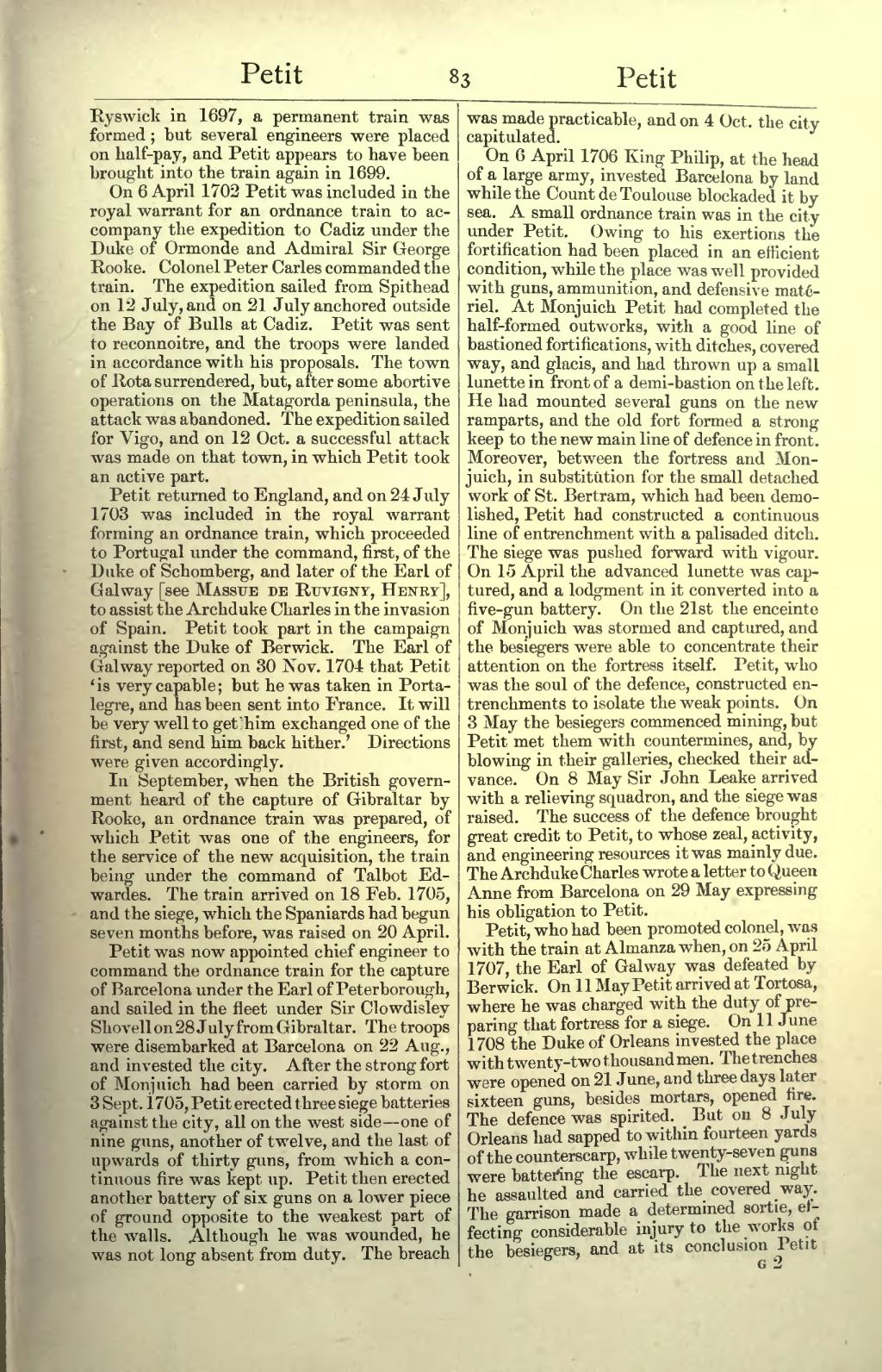Ryswick in 1697, a permanent train was formed; but several engineers were placed on half-pay, and Petit appears to have been brought into the train again in 1699.
On 6 April 1702 Petit was included in the royal warrant for an ordnance train to accompany the expedition to Cadiz under the Duke of Ormonde and Admiral Sir George Rooke. Colonel Peter Carles commanded the train. The expedition sailed from Spithead on 12 July, and on 21 July anchored outside the Bay of Bulls at Cadiz. Petit was sent to reconnoitre, and the troops were landed in accordance with his proposals. The town of Rota surrendered, but, after some abortive operations on the Matagorda peninsula, the attack was abandoned. The expedition sailed for Vigo, and on 12 Oct. a successful attack was made on that town, in which Petit took an active part.
Petit returned to England, and on 24 July 1703 was included in the royal warrant forming an ordnance train, which proceeded to Portugal under the command, first, of the Duke of Schomberg, and later of the Earl of Galway [see Massue de Ruvigny, Henry], to assist the Archduke Charles in the invasion of Spain. Petit took part in the campaign against the Duke of Berwick. The Earl of Galway reported on 30 Nov. 1704 that Petit ‘is very capable; but he was taken in Portalegre, and has been sent into France. It will be very well to get him exchanged one of the first, and send him back hither.’ Directions were given accordingly.
In September, when the British government heard of the capture of Gibraltar by Rooke, an ordnance train was prepared, of which Petit was one of the engineers, for the service of the new acquisition, the train being under the command of Talbot Edwardes. The train arrived on 18 Feb. 1705, and the siege, which the Spaniards had begun seven months before, was raised on 20 April.
Petit was now appointed chief engineer to command the ordnance train for the capture of Barcelona under the Earl of Peterborough, and sailed in the fleet under Sir Clowdisley Shovell on 28 July from Gibraltar. The troops were disembarked at Barcelona on 22 Aug., and invested the city. After the strong fort of Monjuich had been carried by storm on 3 Sept. 1705, Petit erected three siege batteries against the city, all on the west side—one of nine guns, another of twelve, and the last of upwards of thirty guns, from which a continuous fire was kept up. Petit then erected another battery of six guns on a lower piece of ground opposite to the weakest part of the walls. Although he was wounded, he was not long absent from duty. The breach was made practicable, and on 4 Oct. the city capitulated.
On 6 April 1706 King Philip, at the head of a large army, invested Barcelona by land while the Count de Toulouse blockaded it by sea. A small ordnance train was in the city under Petit. Owing to his exertions the fortification had been placed in an efficient condition, while the place was well provided with guns, ammunition, and defensive materiel. At Monjuich Petit had completed the half-formed outworks, with a good line of bastioned fortifications, with ditches, covered way, and glacis, and had thrown up a small lunette in front of a demi-bastion on the left. He had mounted several guns on the new ramparts, and the old fort formed a strong keep to the new main line of defence in front. Moreover, between the fortress and Monjuich, in substitution for the small detached work of St. Bertram, which had been demolished, Petit had constructed a continuous line of entrenchment with a palisaded ditch. The siege was pushed forward with vigour. On 15 April the advanced lunette was captured, and a lodgment in it converted into a five-gun battery. On the 21st the enceinte of Monjuich was stormed and captured, and the besiegers were able to concentrate their attention on the fortress itself. Petit, who was the soul of the defence, constructed entrenchments to isolate the weak points. On 3 May the besiegers commenced mining, but Petit met them with countermines, and, by blowing in their galleries, checked their advance. On 8 May Sir John Leake arrived with a relieving squadron, and the siege was raised. The success of the defence brought great credit to Petit, to whose zeal, activity, and engineering resources it was mainly due. The Archduke Charles wrote a letter to Queen Anne from Barcelona on 29 May expressing his obligation to Petit.
Petit, who had been promoted colonel, was with the train at Almanza when, on 25 April 1707, the Earl of Galway was defeated by Berwick. On 11 May Petit arrived at Tortosa, where he was charged with the duty of preparing that fortress for a siege. On 11 June 1708 the Duke of Orleans invested the place with twenty-two thousand men. The trenches were opened on 21 June, and three days later sixteen guns, besides mortars, opened fire. The defence was spirited. But on 8 July Orleans had sapped to within fourteen yards of the counterscarp, while twenty-seven guns were battering the escarp. The next night he assaulted and carried the covered way. The garrison made a determined sortie, effecting considerable injury to the works of the besiegers, and at its conclusion Petit
